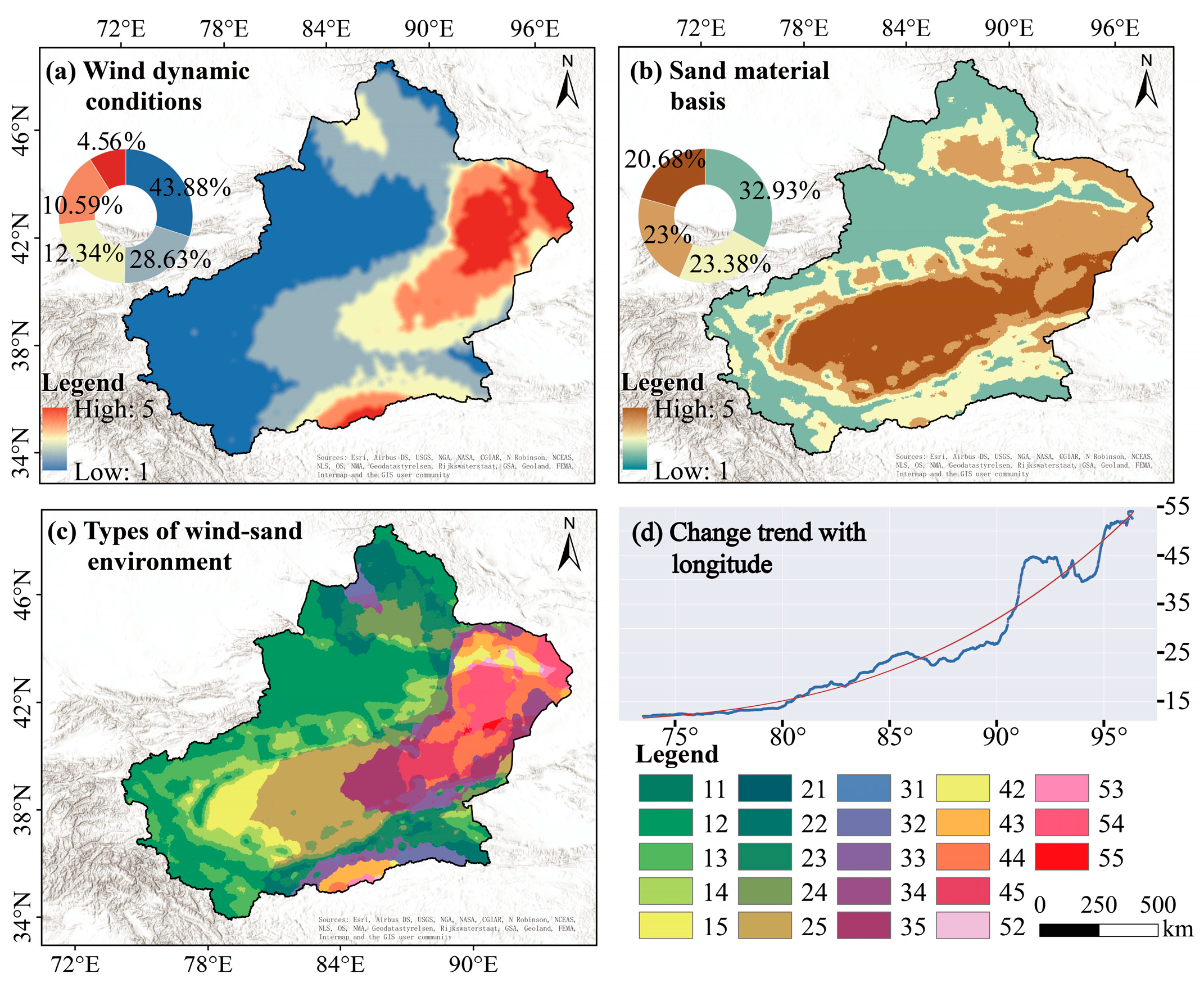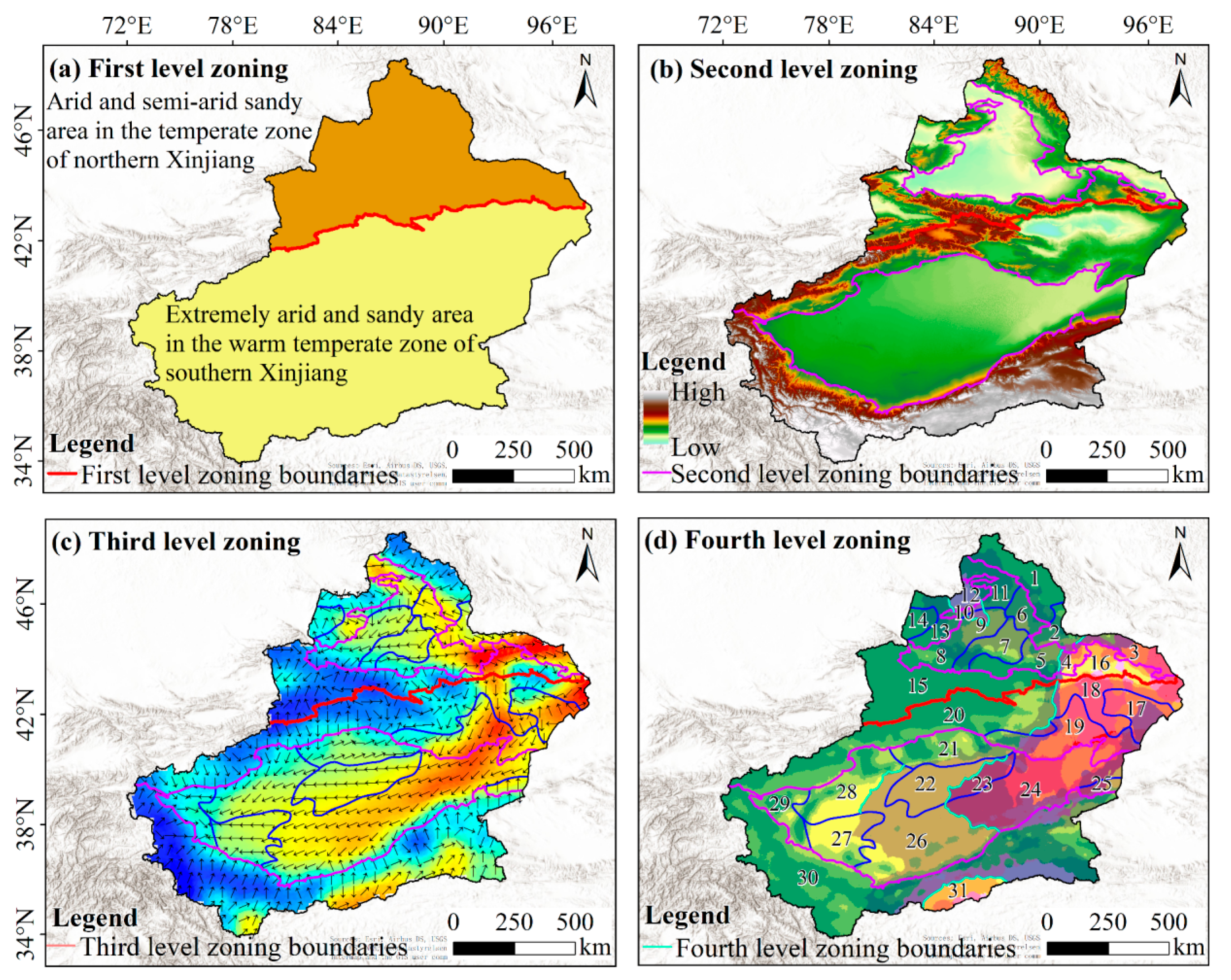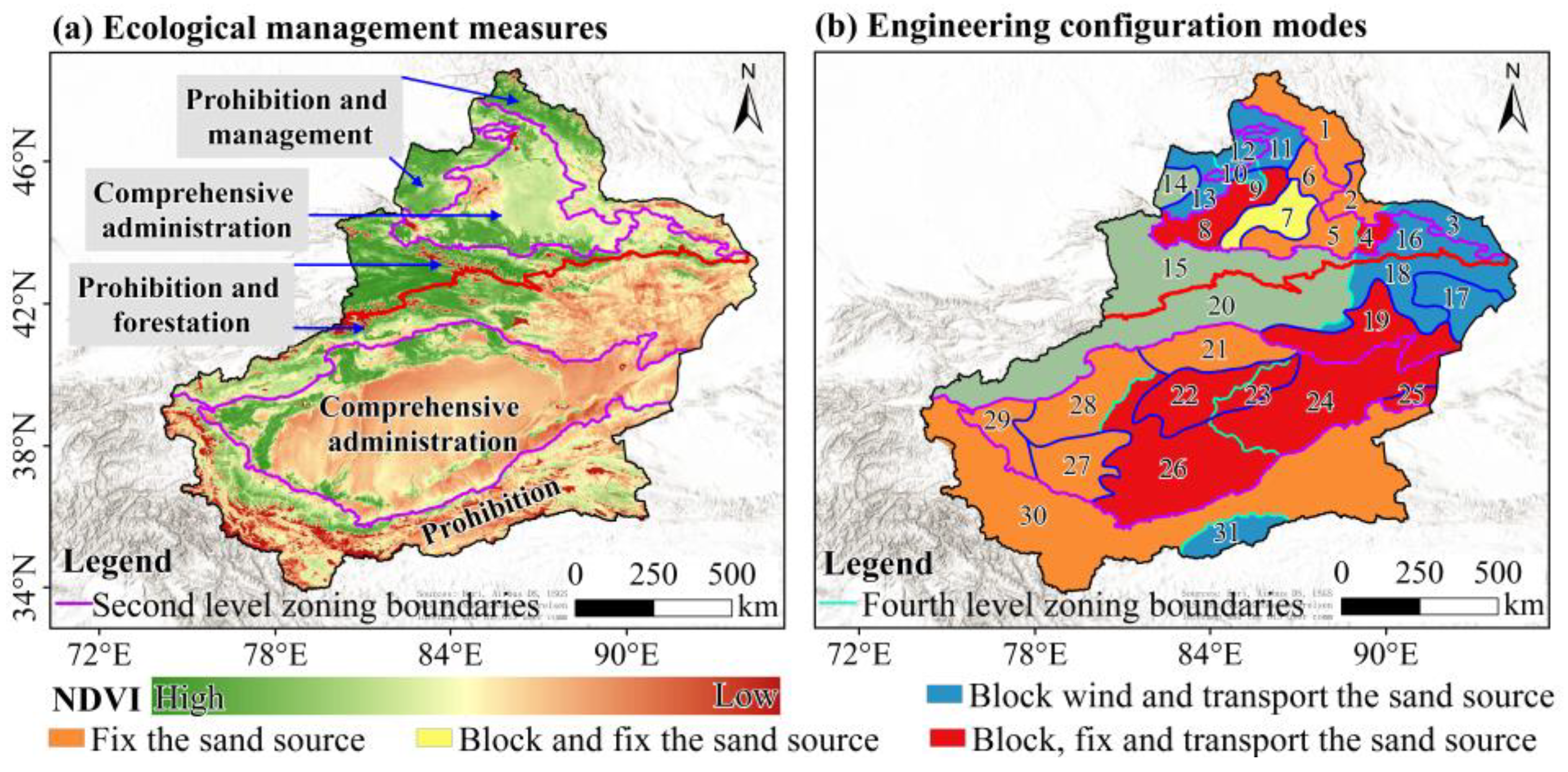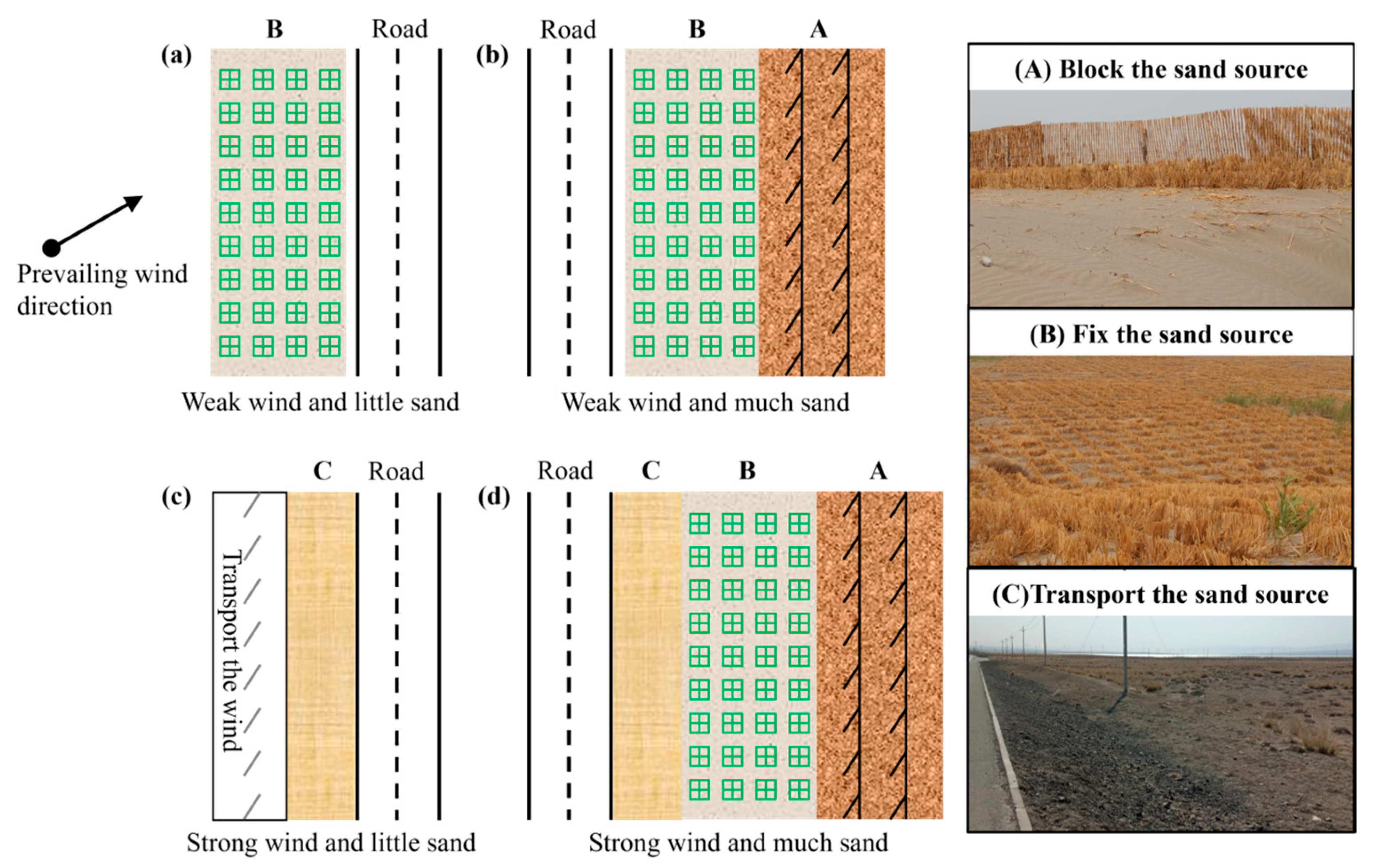Aeolian Environment Regionalization in Xinjiang and Suggestions for Sand Prevention in Typical Areas
Abstract
:1. Introduction
2. Materials and Methods
2.1. Study Area
2.2. Data Sources
2.3. Research Methodology
2.3.1. Diagnosis of Multicollinearity in Evaluation Indicators
2.3.2. Wind Power and Sand Source Abundance Assessment Model and Classification of Aeolian Environments
2.3.3. Aeolian Environment Regionalization in Xinjiang
Zoning Objectives
Zoning Principles
Zoning Methodology
3. Results
3.1. Spatial Distribution of Aeolian Environmental Types in Xinjiang
3.2. Aeolian Environmental Regionalization Results
4. Discussion
4.1. Causes of Spatial Differentiation of Aeolian Environments in Xinjiang
4.2. Countermeasures against Sand Prevention in Typical Aeolian Environment Regionalization
4.2.1. Measures for Ecological Management in the Subregion of Aeolian Environments
4.2.2. Structural Models of Sand Control Systems for Roads in Sandy Areas
4.3. Enlightenment
5. Conclusions
- (1)
- Significant spatial differences characterize the aeolian environment and its types in the Xinjiang region. The wind energy environment throughout the Xinjiang region is high in the east, low in the west, high in the basins, and low in the mountains. The overall wind energy environment of the whole region is dominated by low energy (RDP < 200VU; 91.77%). The spatial variability of the sand material base across Xinjiang is closely related to land-use types, with uneven distribution of soil moisture being the dominant cause.
- (2)
- A four-level zoning scheme was formulated for Xinjiang’s aeolian environment. Two level 1 zones were demarcated, with Tianshan Mountain as the demarcation line; seven level 2 zones were demarcated based on the significant geomorphological units of Xinjiang; 22 level 3 zones were demarcated based on the dominant wind direction; and 31 level 4 zones were demarcated based on the aeolian type.
- (3)
- Based on the secondary zoning’s aeolian environment characteristics and sustainable development priorities, ecological management measures of sealing and conservation, management and nourishment, afforestation and nourishment, and comprehensive management were proposed. According to the differences between regional aeolian environment types, the engineering configuration mode was divided into four categories: fixed-type sand control measures, blocking and fixing sand control measures, wind-blocking and sand-transferring sand control measures, and flexible combinations of blocking, fixing, and sand-transferring sand control measures.
Author Contributions
Funding
Institutional Review Board Statement
Informed Consent Statement
Data Availability Statement
Conflicts of Interest
References
- Shi, P.; Yan, P.; Yuan, Y. Analysis of the driving forces of sandstorm activities in northern China. Quat. Sci. 2001, 21, 41–47. [Google Scholar] [CrossRef]
- Shao, Y.; Wyrwoll, K.H.; Chappell, A.; Huang, J.; Liu, Z.; McTainsh, G.H.; Mikami, M.; Tanaka, T.Y.; Wang, X.; Yoon, S. Dust cycle: An emerging core theme in Earth system science. Aeolian Res. 2011, 2, 181–204. [Google Scholar] [CrossRef]
- Griffin, D.W. Atmospheric movement of microorganisms in clouds of desert dust and implications for human health. Clin. Microbiol. Rev. 2007, 20, 459–477. [Google Scholar] [CrossRef] [PubMed]
- Lamy, F.; Gersonde, R.; Winckler, G.; Esper, O.; Jaeschke, A.; Kuhn, G.; Ullermann, J.; Martinez-Garcia, A.; Lambert, F.; Kilian, R. Increased dust deposition in the Pacific Southern Ocean during glacial periods. Science 2014, 343, 403–407. [Google Scholar] [CrossRef] [PubMed]
- Aciego, S.M.; Riebe, C.S.; Hart, S.C.; Blakowski, M.A.; Carey, C.J.; Aarons, S.M.; Dove, N.C.; Botthoff, J.K.; Sims, K.W.W.; Aronson, E.L. Dust outpaces bedrock in nutrient supply to montane forest ecosystems. Nat. Commun. 2017, 8, 14800. [Google Scholar] [CrossRef] [PubMed]
- Uno, I.; Eguchi, K.; Yumimoto, K.; Takemura, T.; Shimizu, A.; Uematsu, M.; Liu, Z.Y.; Wang, Z.F.; Hara, Y.; Sugimoto, N. Asian dust transported one full circuit around the globe. Nat. Geosci. 2009, 2, 557–560. [Google Scholar] [CrossRef]
- Guan, M.; Zhang, Z.; Dong, Z. Research progress in risk assessment of sandstorm disasters. J. Desert Res. 2018, 38, 978–988. [Google Scholar]
- Ahmed, M.; Al-Dousari, N.; Al-Dousari, A. The role of dominant perennial native plant species in controlling the mobile sand encroachment and fallen dust problem in Kuwait. Arab. J. Geosci. 2016, 9, 134. [Google Scholar] [CrossRef]
- Karimi, A.; Shirmardi, M.; Hadei, M.; Birgani, Y.T.; Neisi, A.; Takdastan, A.; Goudarzi, G. Concentrations and health effects of short-and long-term exposure to PM2. 5, NO2, and O3 in ambient air of Ahvaz city, Iran (2014–2017). Ecotoxicol. Environ. Saf. 2019, 180, 542–548. [Google Scholar] [CrossRef]
- Lei, J.; Wang, X.; Wang, D.; Zhou, C.; Xia, X. The blown sand disaster to the Tarim Desert Highway in Xinjiang, China. Sci. China Ser. D Earth Sci. 2002, 45, 165–173. [Google Scholar] [CrossRef]
- Wang, J.; Hu, J.; Ma, K. Wind speed probability distribution estimation and wind energy assessment. Renew. Sust. Energ. Rev. 2016, 60, 881–899. [Google Scholar] [CrossRef]
- Wang, Z.; Liu, W. Wind energy potential assessment based on wind speed, its direction and power data. Sci. Rep. 2021, 11, 16879. [Google Scholar] [CrossRef] [PubMed]
- Wang, X.; Dong, Z.; Yan, P.; Zhang, J.; Qian, G. Wind energy environments and dunefield activity in the Chinese deserts. Geomorphology 2005, 65, 33–48. [Google Scholar] [CrossRef]
- Gonzalez, L.; Briottet, X. North Africa and Saudi Arabia day/night sandstorm survey (NASCube). Remote Sens. 2017, 9, 896. [Google Scholar] [CrossRef]
- Barnaba, F.; Romero, N.A.; Bolignano, A.; Basart, S.; Matteo, R.; Massimo, S. Multiannual assessment of the desert dust impact on air quality in Italy combining PM10 data with physics-based and geostatistical models. Environ. Int. 2022, 163, 107204. [Google Scholar] [CrossRef] [PubMed]
- Logothetis, S.-A.; Salamalikis, V.; Gkikas, A.; Kazadzis, S.; Amiridis, V.; Kazantzidis, A. 15-year variability of desert dust optical depth on global and regional scales. Atmos. Chem. Phys. 2021, 21, 16499–16529. [Google Scholar] [CrossRef]
- Pan, H.L.; Wang, M.Z.; Kumar, K.R.; Lu, H.; Mamtimin, A.; Huo, W.; Yang, X.H.; Yang, F.; Zhou, C.L. Seasonal and vertical distributions of aerosol type extinction coefficients with an emphasis on the impact of dust aerosol on the microphysical properties of cirrus over the Taklimakan Desert in Northwest China. Atmos. Environ. 2019, 203, 216–227. [Google Scholar] [CrossRef]
- Liu, Y.; Liu, R. A thermal index from MODIS data for dust detection. In Proceedings of the 2011 IEEE International Geoscience and Remote Sensing Symposium, Vancouver, BC, Canada, 24–29 July 2011; pp. 3783–3786. [Google Scholar] [CrossRef]
- Yang, L.; She, L.; Che, Y.; He, X.; Yang, C.; Feng, Z. Analysis of Dust Detection Algorithms Based on FY-4A Satellite Data. Appl. Sci. 2023, 13, 1365. [Google Scholar] [CrossRef]
- Zuo, Y.; Xin, G.; Jia, Q.L. Aeolian disaster risk evaluation in the African Sahel. Sci. Total Environ. 2023, 899, 165462. [Google Scholar] [CrossRef]
- Wang, Y.Z.; Yan, W.H.; Wang, X.P. Risk assessment of wind-sand disaster in Xinjiang, China. J. Desert Res. 2020, 40, 13–21. [Google Scholar]
- Yang, F.; Lu, C. Assessing changes in wind erosion climatic erosivity in China’s dryland region during 1961–2012. J. Geogr. Sci. 2016, 26, 1263–1276. [Google Scholar] [CrossRef]
- Abbasi, H.R.; Opp, C.; Groll, M.; Rohipour, H.; Gohardoust, A. Assessment of the distribution and activity of dunes in Iran based on mobility indices and ground data. Aeolian Res. 2019, 41, 100539. [Google Scholar] [CrossRef]
- Dong, Y. Risk zoning evaluation of desertification disasters in northern China. Acta Geogr. Sin. 1997, 64, 146–153. [Google Scholar]
- Ni, J.; Guo, K.; Liu, H.; Zhang, X. Ecological Regionalization of Arid Areas in Northwest China. Acta Phytoecol. Sin. 2005, 29, 175–184. [Google Scholar] [CrossRef]
- Wang, T.; Xue, X.; Wu, W.; Sun, Q. Zoning of Desertification Prevention and Control in Northern China (Outline). J. Desert Res. 2005, 25, 816–822. [Google Scholar] [CrossRef]
- Gao, H.; Jiang, Q. A Study on the Regionalization of Deserts and Sandy Desertification Land in Northern China Based on Remote Sensing Technology. Chin. J. Geol. Hazard Control 2006, 17, 68–72. [Google Scholar]
- Mao, X.; Wang, F.; Wang, B. A Study on the Natural Regionalization of Highway Deserts in China. J. Highw. Transp. Res. Dev. 2009, 26, 57–60. [Google Scholar] [CrossRef]
- Alimujiang, Y.; Lan, L.; Cheng, H.; Yue, J.; Wang, X. Regionalization of controlling sandy desertification in Xinjiang and suitable controlling techniques and modes of thee regions. Arid. Land. Geogr. 2010, 33, 353–362. [Google Scholar]
- Wang, T.; Liu, S. Zoning of Oasis and Desertification Control in Arid Areas of China (Outline). J. Desert Res. 2013, 33, 959–966. [Google Scholar] [CrossRef]
- Chai, H.; Zhou, C.; Chen, X.; Chen, W. Digital regionalization of geomorphology in Xinjiang. J. Geogr. Sci. 2009, 19, 600–614. [Google Scholar] [CrossRef]
- Cheng, J.J.; Jiang, F.Q.; Xue, C.X.; Xin, G.W.; Li, K.C.; Yang, Y.H. Characteristics of the disastrous wind-sand environment along railways in the Gobi area of Xinjiang, China. Atmos. Environ. 2015, 102, 344–354. [Google Scholar] [CrossRef]
- Jin, C.; Li, Z.; Dong, Z.; Liu, J.; Zhang, T. Study on problems in sand consolidation measures for the Taklimakan desert highway. J. Highw. Transp. Res. Dev. 2007, 2, 1–7. [Google Scholar] [CrossRef]
- Li, S.; Lei, J.; Xu, X.; Qu, J.; Ren, H. Prevention and Control Model and Application of Wind and Sand Hazards on China’s Main Transportation Lines. Chin. Acad. Sci. 2020, 35, 665–674. [Google Scholar] [CrossRef]
- Qu, J.; Wang, T.; Niu, Q.; Liu, B.; Tan, L.; Han, Q.; Gao, Y.; Xiao, J. Mechanisms of the formation of wind-blown sand hazards and the sand control measures in Gobi areas under extremely strong winds along the Lanzhou-Xinjiang high-speed railway. Sci. China Earth Sci. 2023, 66, 292–302. [Google Scholar] [CrossRef]
- Abatzoglou, J.T.; Dobrowski, S.Z.; Parks, S.A.; Hegewisch, K.C. TerraClimate, a high-resolution global dataset of monthly climate and climatic water balance from 1958–2015. Sci. Data 2018, 5, 170191. [Google Scholar] [CrossRef] [PubMed]
- Zhang, R.; Zhang, S.; Luo, J.; Han, Y.; Zhang, J. Analysis of near-surface wind speed change in China during 1958–2015. Theor. Appl. Climatol. 2019, 137, 2785–2801. [Google Scholar] [CrossRef]
- Meloun, M.; Militký, J.; Hill, M.; Brereton, R.G. Crucial problems in regression modelling and their solutions. Analyst 2002, 127, 433–450. [Google Scholar] [CrossRef] [PubMed]
- Office of the Disaster Relief Coordinator of the United Nations (UNDRO). Mitigating Natural Disasters: Phenomena, Effects and Options: A Manual for Policy Makers and Planners; Office of the Disaster Relief Coordinator of the United Nations (UNDRO): New York, NY, USA, 1991. [Google Scholar]
- Gao, X.; Dong, Z.; Duan, Z.; Liu, M.; Cui, X.; Li, J. Wind regime for long-ridge yardangs in the Qaidam Basin, Northwest China. J. Arid. Land. 2019, 11, 701–712. [Google Scholar] [CrossRef]
- Yang, Z.; Gao, X.; Lei, J. Fuzzy comprehensive risk evaluation of aeolian disasters in Xinjiang, Northwest China. Aeolian Res. 2021, 48, 100647. [Google Scholar] [CrossRef]
- Lei, J.; Gao, X.; Zhao, Y.; Du, H.; He, Q.; Ren, H.; Meng, X.; Hu, Z.; Yang, Z. The battle on the edge of Hexi Corridor-Taklimakan Desert: Wind-blown sand situation and prevention tasks of desertification control. Bull. Chin. Acad. Sci. 2023, 38, 966–977. [Google Scholar] [CrossRef]
- Miller, H.J. Tobler’s first law and spatial analysis. Ann. Am. Assoc. Geogr. 2004, 94, 284–289. [Google Scholar] [CrossRef]
- Yue, J.; Alimujiang, Y.; Lan, L.; Cheng, H. Indicators and methods for desertification prevention and control zoning in Xinjiang. Arid Zone Res. 2010, 27, 309–318. [Google Scholar] [CrossRef]
- Sun, H.; Liu, X. Impacts of the uplift of four mountain ranges on the arid climate and dust cycle of inland Asia. Palaeogeogr. Palaeoclimatol. Palaeoecol. 2018, 505, 167–179. [Google Scholar] [CrossRef]
- Wang, W.; Feng, Z. Holocene moisture evolution across the Mongolian Plateau and its surrounding areas: A synthesis of climatic records. Earth-Sci. Rev. 2013, 122, 38–57. [Google Scholar] [CrossRef]
- Yao, J.; Chen, Y.; Guan, X.; Zhao, Y.; Chen, J.; Mao, W. Recent climate and hydrological changes in a mountain–basin system in Xinjiang, China. Earth-Sci. Rev. 2022, 226, 103957. [Google Scholar] [CrossRef]
- Zhu, B.; Yu, J.; Qin, X.; Liu, Z.; Xiong, H. Paleoenvironmental evidence for the formation and evolution of deserts in Xinjiang region. Acta Geogr. Sin. 2013, 68, 661–679. [Google Scholar] [CrossRef]
- Yu, X.; Lei, J.; Gao, X. An over review of desertification in Xinjiang, Northwest China. J. Arid Land. 2022, 14, 1181–1195. [Google Scholar] [CrossRef]
- Rittner, M.; Vermeesch, P.; Carter, A.; Bird, A.; Stevens, T.; Garzanti, E.; Andò, S.; Vezzoli, G.; Dutt, R.; Xu, Z. The provenance of Taklamakan desert sand. Earth Planet. Sci. Lett. 2016, 437, 127–137. [Google Scholar] [CrossRef]
- Jewell, P.W.; Nicoll, K. Wind regimes and aeolian transport in the Great Basin, USA. Geomorphology 2011, 129, 1–13. [Google Scholar] [CrossRef]







| Indicator | Indicator Content | Spatial Resolution | Data Sources | Unit | Indicator Processing |
|---|---|---|---|---|---|
| X1 | Soil organic carbon content | 250 m | OpenLandMap | g/kg | negative |
| X2 | Soil water content | 250 m | OpenLandMap | % | negative |
| X3 | Soil sand content | 250 m | OpenLandMap | % (kg/kg) | positive |
| X4 | Land-use type | 1000 m | Resources and Environmental Science and Data Center, Chinese Academy of Sciences | — | positive |
| X5 | NDVI | 1000 m | Earthdata | — | negative |
| X6 | Precipitation | 2.5′ | TERRACLIMATE | mm | negative |
| X7 | Potential evapotranspiration | 2.5′ | TERRACLIMATE | mm | positive |
| X8 | RDP | 0.1° | European Centre for Medium-Range Weather Forecasts (ECMWF) | VU | positive |
| First Level of Zoning | Second Level of Zoning | Third Level of Zoning | Fourth Level of Zoning | No. |
|---|---|---|---|---|
| Temperate arid and semi-arid wind and sandy areas in northern Xinjiang region | Altay–Beitashan subregion | Altai Mountains and the Jundong hills + Mountains and hills + Northerly and easterly wind areas | Altai Mountains and the Jundong hills + Mountains and hills + Northerly and easterly wind areas + Weak winds and less sandy areas | 1 |
| Beita Mountain–Santang–Nao Mao Lake basin + Mountains and basin + Northerly and westerly wind areas | Northern Beita Mountains + Mountains + Westerly wind areas + Weak winds and less sandy areas | 2 | ||
| Santang–Nao Mao Lake basin + Basin + Northerly and westerly wind areas + Strong winds and less sandy areas | 3 | |||
| Junggar basin subregion | Southeastern Junggar basin + Basin + Northerly and westerly wind areas | Gurbantunggut desert + Desert + Northerly and westerly wind areas + Strong winds and less sandy areas | 4 | |
| Southeastern Junggar basin + Basin + Northerly and westerly wind areas + Weak winds and less sandy areas | 5 | |||
| Ulungu River basin + Basin + Southerly and easterly wind areas | Ulungu River basin + Basin + Southerly and easterly wind areas + Weak winds and less sandy areas | 6 | ||
| Gurbantunggut desert + Desert + Northerly and easterly wind areas | Gurbantunggut desert + Desert + Northerly and easterly wind areas + Weak winds and more sandy areas | 7 | ||
| Southwestern Junggar basin + Basin + Northerly and easterly wind areas | Southwestern Junggar basin + Basin + Northerly and easterly wind areas + moderate winds and less sandy areas | 8 | ||
| Junggar basin + Basin + Northerly and easterly wind areas + Strong winds and less sandy areas | 9 | |||
| Northern Junggar basin + Basin + Northerly and westerly wind areas | Junggar basin + Basin + Northerly and westerly wind areas + Strong winds and less sandy areas | 10 | ||
| Irtysh River valley + Valley + Northerly and westerly wind areas + Strong winds and less sandy areas | 11 | |||
| Mountainous subregion of western Junggar | Tacheng district–Hoboksar basin + Basin + Northerly and westerly wind areas | Hoboksar basin + Basin Northerly and westerly wind areas + Strong winds and less sandy areas | 12 | |
| Tacheng Laofengkou basin + Basin + Northerly and westerly wind areas + Moderate winds and less sandy areas | 13 | |||
| Western Junggar Mountains + Mountain + Complex wind region | Western mountain region of the Junggar basin + Mountain + Complex wind areas + Weak winds and without sand areas | 14 | ||
| Tianshan north slope subregion | Northern Tianshan Mountains + Mountain + Southerly and westerly wind areas | North slope of the Tianshan Mountains + Mountains + Complex wind areas + Weak winds and without sand areas | 15 | |
| Northern Tianshan Mountains + Mountain + Southerly and westerly wind areas | Northern Tianshan Mountains + Mountains + Southerly and westerly wind areas + Strong winds and less sandy areas | 16 | ||
| Warm-temperate extreme arid sandy wind region in southern Xinjiang | Tianshan South Slope subregion | Yandun wind area (southeast of Hami) − Southern Gobi of Hami + Gobi + Southerly and easterly wind areas | Yandun wind area (southeast of Hami) − Southern Gobi of Hami + Gobi + Southerly and easterly wind areas + Strong winds and less sandy areas | 17 |
| Southern edge of Tianshan Mountains + Mountain + Northerly and westerly wind areas | 100 km gale area + Low hills and plains + Northerly and westerly wind areas + Strong winds and less sandy areas | 18 | ||
| South Tianshan Mountains + Mountains + Northerly and westerly wind areas + Weak winds and without sand areas | 20 | |||
| Kuruktag + Mountain + Northerly and easterly wind areas | Kuruktag + Mountains + Northerly and easterly wind areas + Moderate winds and less sandy areas | 19 | ||
| Tarim basin subregion | Southern piedmont of Tianshan plain + Plain + Southerly and westerly wind areas | Southern piedmont of Tianshan plain + Plain + Southerly and westerly wind areas + Weak winds and less sandy areas | 21 | |
| Northern Taklamakan desert + Desert + Easterly wind area | Northern Taklamakan desert + Desert + Easterly wind area + Moderate winds and more sandy areas | 22 | ||
| Northern Taklamakan desert + Desert + Easterly wind area + strong winds and less sandy areas | 23 | |||
| Kumutage desert + Desert + Southerly wind area | Kumutage desert + Desert + Southerly wind area + Moderate winds and more sandy areas | 25 | ||
| Southwestern Tarim basin + Basin + Easterly wind area | Southwestern Tarim basin + Basin + Easterly wind area + Weak winds and less sandy areas | 27 | ||
| Western margin of Tarim basin + Basin + Northerly and westerly wind areas | Western margin of Tarim basin + Basin + Northerly and westerly wind areas + Weak winds and less sandy areas | 29 | ||
| Tarim basin + Basin + Northerly and easterly wind areas | Eastern margin of the Tarim basin + Basin + Northerly and easterly wind areas + Strong winds and more sandy areas | 24 | ||
| Central Tarim basin + Basin Northerly and easterly wind areas + Moderate winds and more sandy areas | 26 | |||
| Yarkant River basin + Basin + Northerly and easterly wind areas + Weak winds and less sandy areas | 28 | |||
| Kunlun–Altun Mountains subregion | Kunlun Mountain–Altun Mountain + Mountain + Easterly and westerly wind areas | Kunlun Mountain–Altun Mountain + Mountain + Easterly and westerly wind areas + Weak winds and less sandy areas | 30 | |
| Northeastern central Kunlun Mountains and Qiangtang plateau + Mountain and plateau + Complex wind areas | Northeastern central Kunlun Mountains and Qiangtang plateau + Mountains and plateau + Complex wind areas + Strong winds and less sandy areas | 31 |
Disclaimer/Publisher’s Note: The statements, opinions and data contained in all publications are solely those of the individual author(s) and contributor(s) and not of MDPI and/or the editor(s). MDPI and/or the editor(s) disclaim responsibility for any injury to people or property resulting from any ideas, methods, instructions or products referred to in the content. |
© 2024 by the authors. Licensee MDPI, Basel, Switzerland. This article is an open access article distributed under the terms and conditions of the Creative Commons Attribution (CC BY) license (https://creativecommons.org/licenses/by/4.0/).
Share and Cite
Zhou, J.; Ren, H.; Han, B.; Zhao, Y.; Wang, H. Aeolian Environment Regionalization in Xinjiang and Suggestions for Sand Prevention in Typical Areas. Land 2024, 13, 1215. https://doi.org/10.3390/land13081215
Zhou J, Ren H, Han B, Zhao Y, Wang H. Aeolian Environment Regionalization in Xinjiang and Suggestions for Sand Prevention in Typical Areas. Land. 2024; 13(8):1215. https://doi.org/10.3390/land13081215
Chicago/Turabian StyleZhou, Jie, Hongjing Ren, Beibei Han, Yazhou Zhao, and Haifeng Wang. 2024. "Aeolian Environment Regionalization in Xinjiang and Suggestions for Sand Prevention in Typical Areas" Land 13, no. 8: 1215. https://doi.org/10.3390/land13081215





